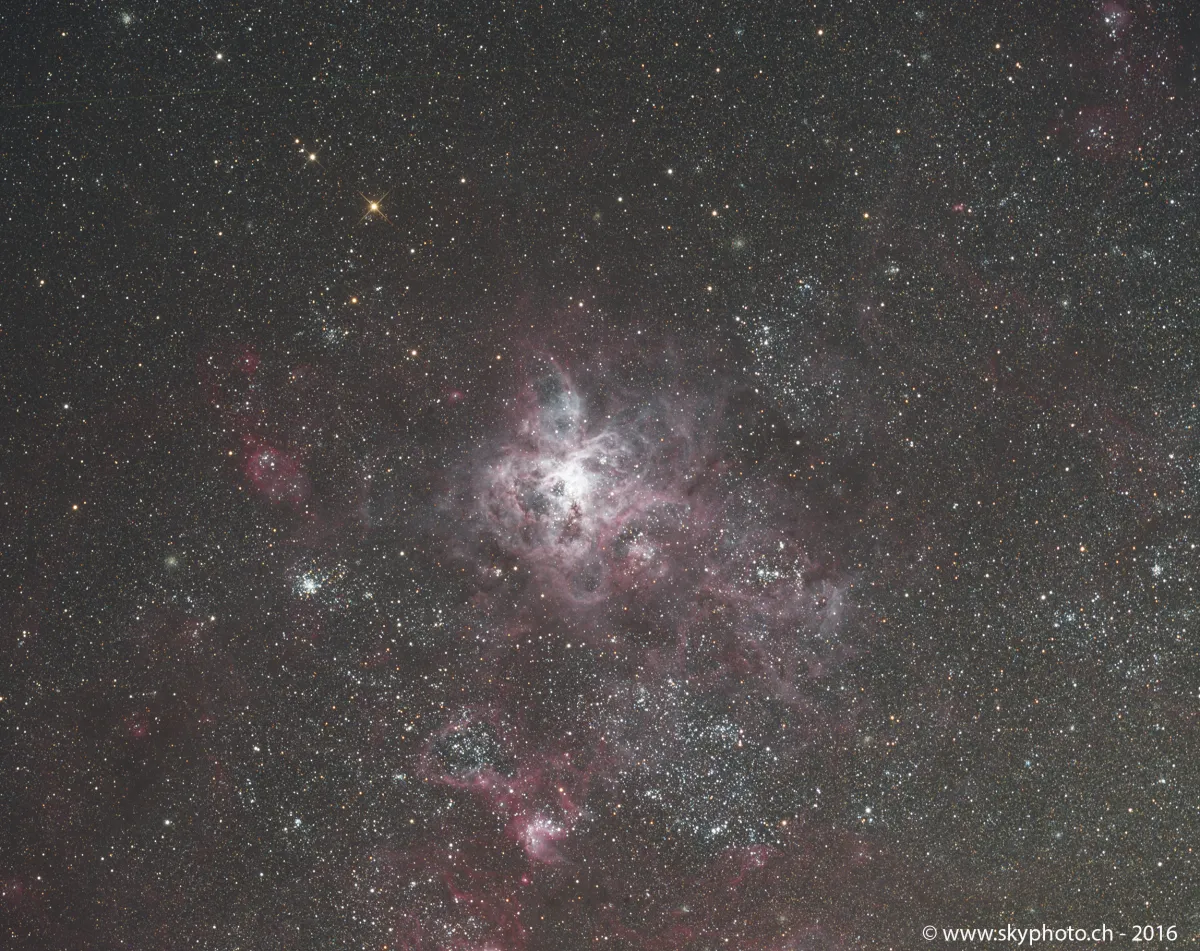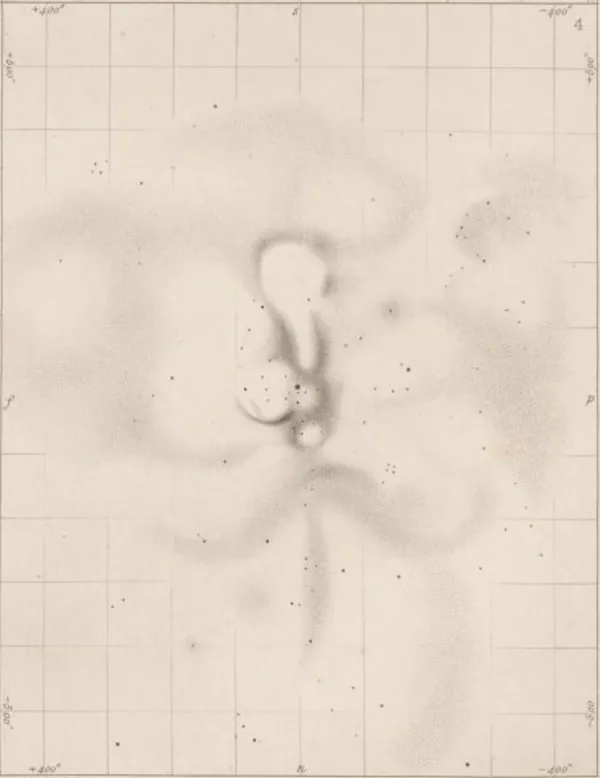Tarantula Nebula, 30 Doradus (NGC 2070)



History
French astronomer Nicolas-Louis de Lacaille discovered this nebula in 1751-1752 during his expedition to the Cape of Good Hope. He listed it in his first list of « nebulae of the first kind, or nebulosities that are not accompanied by any stars visible through a two-foot telescope» and compared it to the appearance of globular cluster NGC 104. [8]
In 1801 German Astronomer Johann Elert Bode listed this this nebula in the addendom to his Uranographia and gave it the stellar designation «30 Doradus» but stated, that it was nebulous. [714]
Scottish Astronomer James Dunlop made eight observations in 1826-1827 using his 9-inch reflecting telescope at his home in Parramatta (NSW) in Australia. He listed 30 Doradus as Δ 142 and wrote: «A pretty large ill-defined nebula, of an irregular branched figure, with a pretty bright small star in the south side of the centre, which gives it the appearance of a nucleus. This is resolvable into very minute stars. Figure 4. is a very good representation of the nebula resolved. (N.B. The 30 Doradus is surrounded by a number of nebulae of considerable magnitudes, nine or ten in number, with the 30 Doradus in the centre.)» [50]

John Herschel observed the nebula from South Africa and listed the main part as h 2941. He wrote: «This is one of the most singular and extraordinary objects which the heavens present, and derives no small addition to its intrinsic interest from its situation, which is among the thickest of the nebulae and clustering groups of the greater Nubecula, of whose total area it occupies one-five hundredth part. For these reasons, as well as because its real nature has been completely misunderstood, and its magnified appearance so strangely misrepresented in the only figure which I am aware to have been made of it as to convey an entirely erroneous impression both of its form and structure; I have taken great pains to give as nearly as possible a perfect representation of it as it appeared in the twenty-feet reflector on a great many occasions, but more especially on the 29th November, 1834, when a 'very careful drawing' was made of it by the eye alone, unaided by any micrometrical measures; and on the 21st and 22nd December, 1835, when the nebula was worked in from the telescope on a 'skeleton' previously prepared by an approximate reduction of the micrometrical measures of its principle stars, forming a chart, with a system of triangles, for its reception and for that of minute stars not susceptible of micrometric measurement, or not considered as of sufficient importance to be so measured. This is the only mode in which correct monographs can be executed of nebulae of this kind which consist of complicated windings and ill-defined members obliterated by the smallest illumination of the field of view; and in which the small stars, when very numerous, can be mapped down with tolerable precision.» [11]
Physical Properties
| Name | RA | Dec | Type | bMag | vMag | Dim | MD | Dreyer Description | Identification, Remarks |
|---|---|---|---|---|---|---|---|---|---|
| NGC 2033 | 05 34 30.6 | -69 46 48 | OCL | 11.6 | 0.5 | 49.970 | Cl, in Nubec major | h (579); GC 1236; ESO 56-SC157; in LMC | |
| NGC 2037 | 05 34 54.0 | -69 44 12 | OCL | 10.3 | 0.5 | 49.970 | Cl, in Nubec major | h (593); GC 1240; ESO 56-SC159; in N 2033 | |
| NGC 2042 | 05 36 09.6 | -68 55 25 | OCL | 9.8 | 9.6 | 9 | 49.970 | Cl, vL, Ri, st 12…15 | h 2922; GC 1245; ESO 56-SC163; in LMC |
| NGC 2044 | 05 36 06.0 | -69 11 55 | OCL | 10.7 | 10.6 | 2 | 49.970 | Cl, in Nubec major | h (608); GC 1246; ESO 56-SC165; in LMC |
| NGC 2048 | 05 35 55.4 | -69 38 58 | EN+* | 0.5 | 49.970 | vF, L, pmE | h 2926; GC 1250; ESO 56-*N166; in LMC | ||
| NGC 2050 | 05 36 38.9 | -69 23 01 | OCL | 9.5 | 9.3 | 1 | 49.970 | Cl + neb, mC, iF, st vS | h 2928; GC 1252; ESO 56-SC170; in LMC |
| NGC 2055 | 05 37 03.0 | -69 25 54 | OCL | 8.5 | 8.4 | 0.6 | 49.970 | Cl, vL, Ri, st 10…15 | h 2931; GC 1256; ESO 56-SC171; in LMC |
| NGC 2060 | 05 37 51.6 | -69 10 23 | SNR | 9.7 | 9.6 | 49.970 | neb, no descrip, in Nub maj | h (642); GC 1261; ESO 57-EN1; in LMC | |
| NGC 2069 | 05 38 40.0 | -69 00 18 | EN | 49.970 | F, L, E | h 2940; GC 1268; ESO 57-EN7; part of N 2070; in LMC | |||
| NGC 2070 | 05 38 42.5 | -69 06 03 | EN | 5.0 | 30 × 20 | 49.970 | !!! vB, vL, looped | h 2941; GC 1269; ESO 57-EN6; Tarantula nebula (30 Dor); in LMC | |
| NGC 2074 | 05 39 03.6 | -69 29 53 | EN | 8.5 | 49.970 | pB, pL, mE, 5 st inv | h 2942; GC 1272; ESO 57-EN8; in LMC, part of N 2070 | ||
| NGC 2077 | 05 39 36.0 | -69 39 26 | EN | 15 × 15 | 49.970 | F, R, p of D neb | h 2947; GC 1275; ESO 57-EN9; in LMC | ||
| NGC 2078 | 05 39 39.3 | -69 44 38 | EN | 49.970 | neb, np of gr of 7 | h 2948; GC 1276; ESO 57-EN10; in N 2079 group; in LMC | |||
| NGC 2079 | 05 39 40.0 | -69 46 26 | EN | 49.970 | neb, sp of gr of 7 | h 2949; GC 1277; ESO 57-EN11; in LMC | |||
| NGC 2080 | 05 39 44.2 | -69 38 44 | EN | 49.970 | B, R, f of D neb | h 2950; GC 1278; ESO 57-EN12; in LMC | |||
| NGC 2081 | 05 39 59.5 | -69 24 21 | OCL (OCL+EN) | 49.970 | Cl, vF, mC, st + neb | h 2951; GC 1279; ESO 57-SC13; in LMC | |||
| NGC 2083 | 05 39 59.3 | -69 44 16 | EN | 49.970 | neb, nf of gr of 7 | h 2952; GC 1281; ESO 57-EN14; in N 2079 group; in LMC | |||
| NGC 2084 | 05 40 07.1 | -69 45 34 | EN | 49.970 | neb, sf of gr of 7 | h 2953; GC 1282; ESO 57-EN15; in N 2079 group; in LMC | |||
| NGC 2085 | 05 40 09.0 | -69 40 24 | EN | 49.970 | vF, R, * 10 v nr | h 2954; GC 1283; ESO 57-EN16; in LMC | |||
| NGC 2086 | 05 40 13.0 | -69 40 05 | EN | 49.970 | B, pS, R, lbM, * 10 p | h 2956; GC 1284; ESO 57-EN17; in LMC | |||
| NGC 2088 | 05 40 59.9 | -68 27 56 | OCL | 12.8 | 12.5 | 1.7 | 49.970 | vF, S, R | h 2955; GC 1286; ESO 57-SC20; in LMC |
| NGC 2091 | 05 40 58.1 | -69 26 14 | OCL | 12.4 | 12.1 | 1.7 | 49.970 | vF, S, mE, glbM, ? D | h 2957; GC 1289; ESO 57-SC21; in LMC |
| NGC 2092 | 05 41 22.1 | -69 13 27 | OCL | 1.2 | 49.970 | vF, pL, R, rr | h 2962; GC 1290; ESO 57-SC22; in LMC | ||
| NGC 2093 | 05 41 49.8 | -68 55 17 | OCL | 11.9 | 11.6 | 1.7 | 49.970 | vF, S, R | h 2963; GC 1291; ESO 57-SC23; in LMC |
| NGC 2094 | 05 42 08.0 | -68 21 48 | OCL | 49.970 | vF, S, R | h 2959; GC 1292; ESO 57-SC26; in LMC | |||
| NGC 2096 | 05 42 17.9 | -68 27 31 | OCL | 11.8 | 11.3 | 1.2 | 49.970 | neb, no descrip, in Nub major | h (725); GC 1294; ESO 57-SC27; in LMC |
| NGC 2098 | 05 42 30.4 | -68 16 32 | OCL | 10.9 | 10.7 | 1.6 | 49.970 | globular, B, S, rr | h 2965; GC 1297; ESO 57-SC28; in LMC |
| NGC 2100 | 05 42 09.1 | -69 12 43 | OCL | 9.6 | 2.8 | 49.970 | globular, B, pL, irrR, rr | h 2966; GC 1298; ESO 57-SC25; in LMC | |
| NGC 2102 | 05 42 20.6 | -69 29 14 | OCL | 11.4 | 1 | 49.970 | neb, no descrip, in Nub maj | h (730); GC 1300; ESO 57-SC29; in LMC | |
| NGC 2108 | 05 43 55.3 | -69 10 51 | OCL | 12.9 | 12.8 | 2 | 49.970 | eF, pL, lE | h 2970; GC 1306; ESO 57-SC33; in LMC |
| NGC 2109 | 05 44 23.0 | -68 32 52 | OCL | 12.6 | 12.2 | 2 | 49.970 | F, pS, R, vglbM | h 2972; GC 1307; ESO 57-SC34; in LMC |
| NGC 2113 | 05 45 24.6 | -69 46 27 | OCL (OCL+EN) | 12.3 | 1.8 | 49.970 | Cl, F, S, iF, vlC, rr | h 2975; GC 1311; ESO 57-EN36; in LMC | |
| NGC 2116 | 05 47 15.2 | -68 30 29 | OCL | 13.2 | 12.9 | 1 | 49.970 | F, S, R, * 11 p | h 2977; GC 1314; ESO 57-SC38; in LMC |
| NGC 2118 | 05 47 39.6 | -69 07 55 | OCL | 12.0 | 1.3 | 49.970 | globular, vB, vS, vsmbM, rr | h 2979; GC 1316; ESO 57-SC39; in LMC |
Finder Chart
The Tarantula Nebula can be found in the Large Magellanic Cloud, which northern part is located in the constellation Dorado and the southern part is in Mensa. Unfortunately it is not visible from Europe. On 18 December it in opposition with the Sun and is therefore highest in the sky at local midnight.
Visual Observation
635 mm Aperture: One could spend an eternity wandering around and following all glowing filaments and patches that spread out from the Tarantula Nebula into the Large Magellanic Cloud. It resembles a bit the well known Cirrus Nebula, but much larger and more complex. It also appears much brighter, although it is much further away in our neighbouring galaxy. Maybe that was also caused due to the low light pollution in Namibia. There at most, the zodiacal light after sunset or the rising Venus in the morning was a disturbance. — 25" f/4 Obession Dobsonian, Astrofarm Tivoli, Namibia, September 2023, Bernd Nies
